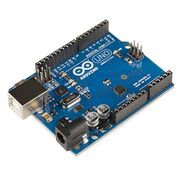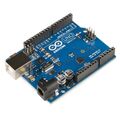Arduino
 | |
| Status | in progress |
|---|---|
| Source code | ols |
| Channels | 6 |
| Samplerate | 4MHz |
| Samplerate (state) | — |
| Triggers | none (SW-only) |
| Min/max voltage | -0.5V — 5.5V |
| Threshold voltage | Fixed: VIH=3.0V—5V, VIL=0V—1.5V |
| Memory | ATmega168: 532 (or lower), ATmega328: 1024 (or lower), ATmega2560: 7168 (or lower) |
| Compression | RLE |
| Website | github.com/gillham/logic_analyzer |
SUMP protocol implementation for Arduino.
Hardware
- Main chip: Atmel ATmega168/328/2560
- Input pins: With optional internal pullups (currently has to be modified at compile-time)
- 3.3V and 5V output: 3.3V, 5V
- 16MHz crystal: 16.000
Photos
Protocol
- This uses the extended SUMP protocol as implemented by sigrok in ols driver.
Problems
Everything looks almost fine, device loads in pulseview, but there are still some cosmetic issues left to tackle:
- Buffer is currently sent or parsed backwards (time goes from right to left/zero)!!! (not sure if problem lays in arduino code or sigrok)
- RLE (=continuous capture) is not properly implemented in sigrok/ols driver, therefore capture length is limited by device memory
- Maximum supported samplerate is reported by device and received by sigrok, but not reflected in pulseview GUI
- Triggering is still a work in progress, but generally works for samples below 1MHz. over 1MHz works for a basic busy wait trigger that doesn't store until after the trigger fires.
FTDI-LA (alternative approach)
Note that some older arduino designs and arduino clones feature FTDI usb-serial chip, which might be used as logic analyzer as well using FTDI-LA. This has nothing to do with OLS driver described on this page and i mention it just for completeness. Also note that Arduino boards wire FTDI to ATmega chips and that might cause you some troubles. If atmega pins connected to FTDI are configured as outputs or pullups, it can mess up the measurements or even damage the ATmega (given you apply voltage to it). So make sure you know what are you doing. In best case scenario you have arduino board with DIP socket, which allows you to remove atmega completely from board when you use it with FTDI-LA driver.

